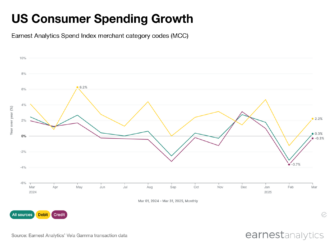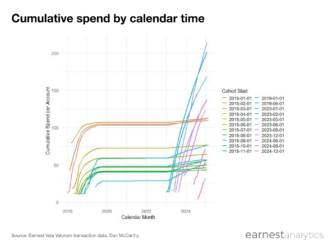Can You Venmo Me?
The Evolving Landscape of Peer to Peer Payments
Peer-to-Peer (P2P) transfers have grown rapidly over the past several years. We analyzed the credit, debit and ACH records of millions of anonymous U.S. consumers to better understand the key players in the space, nuances related to consumer behavior, and growth in monetizable transactions.
Key Takeaways
- The P2P market, which has grown more than 20x since 2015, remains dominated by Venmo but new entrants have been increasing their share in recent years.
- Average ticket size for all of the P2P platforms tends to be ~20-60% higher in weeks containing the first day of the month compared to other weeks.
- Venmo users appear to be increasingly comfortable leaving a balance on the Venmo platform. The share of total dollars that were cashed out of the system vs. sent into the system was ~50% back in 2015, and has since declined to ~43%.
- ACH continues to be the primary funding source for both PayPal and Venmo. PayPal’s funding mix has remained relatively stable, exhibiting only a slight uptick in debit and credit card linked accounts in recent years.
- Venmo peer-to-merchant activity continues to grow, led by Uber and Grubhub/Seamless, but still represents a very small percentage (just ~1.0% in the data) of overall Venmo TPV.
Market Share
Launched in 2009, Venmo (owned by PayPal) is the dominant player, but has ceded share to new entrants in recent years. Cash App (f.k.a. Square Cash) has been a strong competitor, strengthening its position against Venmo after adding new services like bitcoin trading and instant deposit in 2017. Apple and Facebook are smaller players, but process a non-negligible amount of volume.

Average Ticket Analysis
Each of the P2P services see increased processing volume around the first day of each month, driven almost entirely by a higher average ticket. As seen below, average ticket tends to be ~20-60% higher in weeks containing the first day of the month compared to other weeks. This can perhaps be explained, for example, by individuals reimbursing their roommates for rent and utility bill payments. Also of note, Venmo consistently displays a higher weekly average ticket than Cash App, possibly indicating Venmo has higher-income users than those of Cash App.

Venmo Cash-Ins vs. Cash-Outs
Venmo users appear to be increasingly comfortable leaving a balance on the Venmo platform. The share of total dollars that were cashed out of the system vs. sent into the system was ~50% back in 2015. It has since declined to ~43%. Less frequent cash outs have also yielded higher average dollar amounts cashed out over time, increasing ~10% from $180 in 2015 to $198 today. This is in contrast to a ~5% increase in the average amount of money going into the system, from $107 in 2015 to $112 today.

Monetization Efforts
Despite impressive volume growth in P2P services, monetizing this volume has proven to be difficult thus far. Venmo and Cash App currently charge consumers for 1) instant deposits to their bank accounts and 2) funding accounts with a credit card. Additionally, they collect transaction fees when acting as an intermediary, including its Pay with Venmo initiative, for merchant transactions.
Funding Source
PayPal has been effective in diversifying its transaction base across different funding sources. Though ACH had been growing for several years as a percent of total, new partnerships with card networks in 2017 and 2018 provided a small uptick in the percent of transaction volume coming from debit and credit cards.

On the other hand, Venmo has been much more heavily comprised of ACH transactions. New partnerships with card networks increased the share of transactions funded with debit cards, most notably in 2018, but volume from credit cards has not materially increased.

Merchant Payment Efforts
Venmo has also been trying to increase its role as a merchant payment method. While still a very small percentage of Venmo’s Total Payment Volume (TPV), we’ve identified the top five merchants in terms of usage on the platform and plotted monthly activity over time. We also included “reloads” onto the recently rolled out merchant debit card (Venmo will automatically pull funds from the user’s bank account, in increments of $10, when a transaction exceeds the user’s balance).
While still an early initiative, Venmo merchant activity continues to grow, led by Uber and Grubhub/Seamless, but still represents a very small percentage (just ~1.0% in the data) of overall Venmo TPV.

Notes:
-Earnest data only tracks activity from the user’s linked funding source (bank account or debit/credit card); it is blind to intra-platform activity when the user’s balance is sufficiently funded to fulfill the entire payment or transfer amount.
-Earnest data only tracks reload activity onto the Venmo debit card; not activity at the POS.
-Earnest data does not track any merchant spend for Cash App, as users must load money into their accounts prior to spending on their Cash Cards at merchants.











